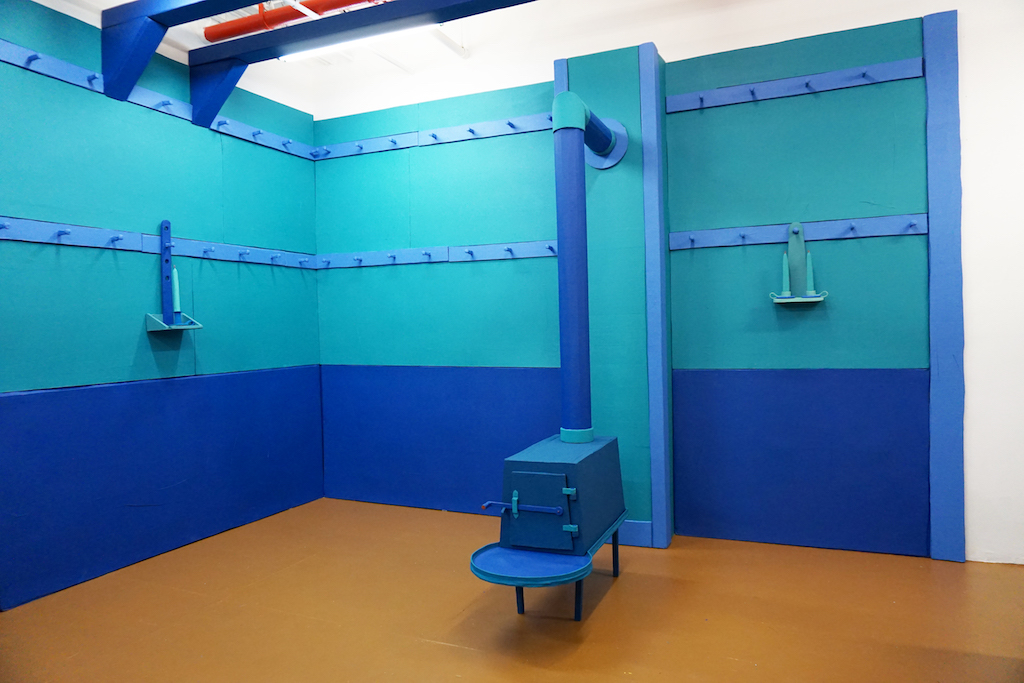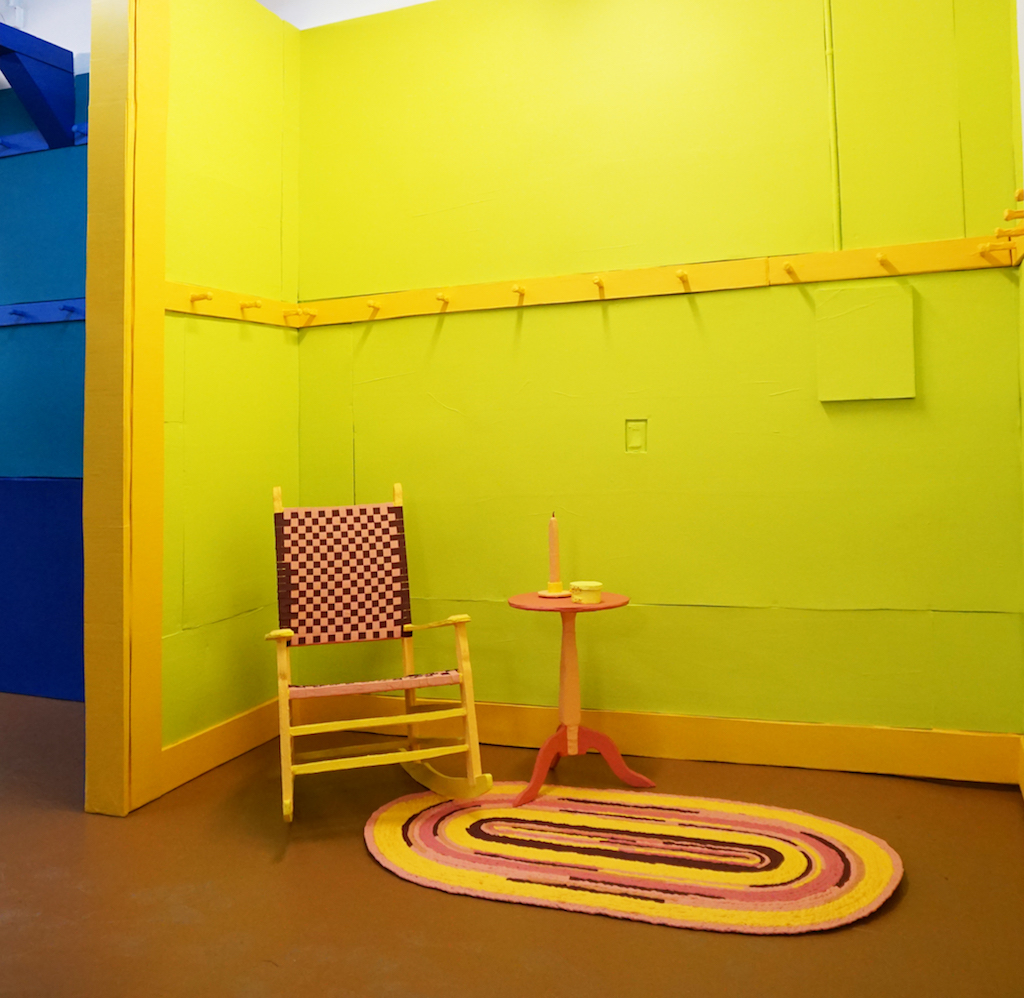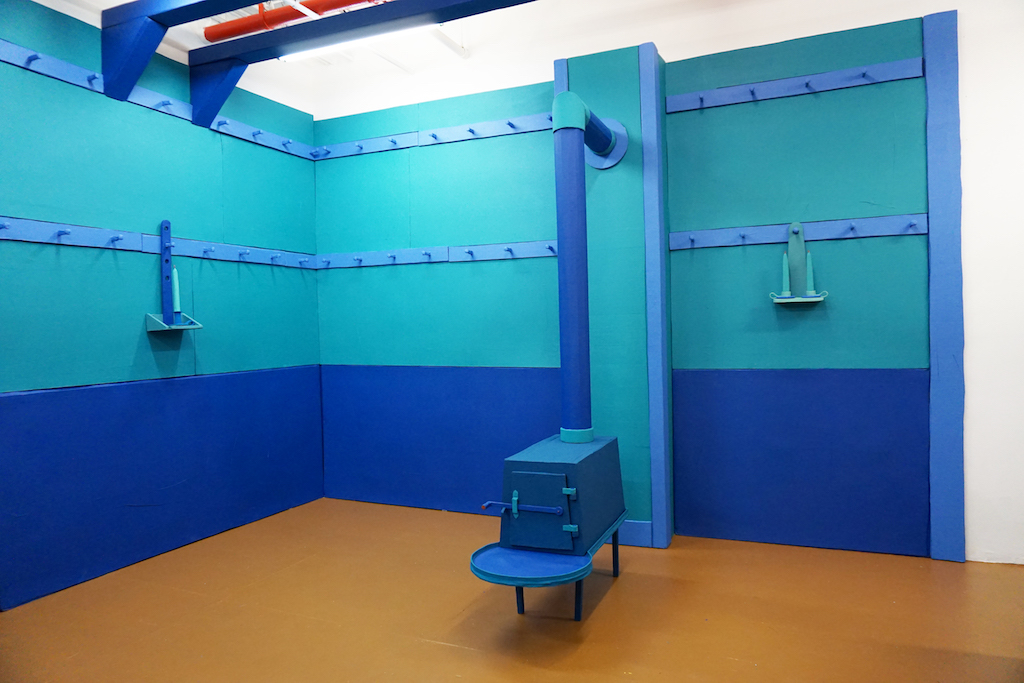[ad_1]

Amie Cunat, Meetinghouse, installation view, 2018.
COURTESY THE ARTIST AND VICTORI+MO
“I think in all of the work there might be this initial misconception that I’m trying to be funny,” the artist Amie Cunat said, while sitting in her multi-room installation at Victori+Mo in Bushwick, Brooklyn. “I am interested in those responses, but when you sit with it for a while, the work always sort of leans into something that’s a bit darker.”
Indeed, Cunat’s exhibition, “Meetinghouse,” is an ostensibly buoyant presentation of three brightly painted spaces housing furniture made mostly out of just paper or cardboard. But these vibrant rooms—a neon yellow foyer, a large space in various shades of blue, and a secret, closet-like area—along with the whimsical items that fill them, grapple with American history, focusing on the legacy of the Shakers, the nearly-extinct Christian sect famous for its celibacy, pacifism, peaceful protest, communalism, and highly functional craftsmanship, which Cunat recasts in a Pop register.
The installation features candle sticks, a stove (complete with piping and a working door), Shaker boxes, a rocking chair, a broom, and a rug, among other objects, and the spaces include architectural details like beams, baseboards, and wainscoting that are delineated by color, lending a sense of realism to the otherwise otherworldly rooms. Throughout conceiving the show, Cunat consulted books about the textiles and furniture making of the Shakers, whose name comes from the frenetic dancing they performed in some worship sessions. (That dancing figured prominently in the 1983–84 Dan Graham classic Rock My Religion.)
By centering the visual traditions of the Shakers, who were remarkably egalitarian and socially progressive for their time, Cunat said, she wanted draw attention to non-violent protests today. However, hers is not a piece about nostalgia. The artist talked at length about the “futility” of idealizing and attempting to resurrect America’s past, and her use of paper could be an indicator of the flimsy nature of such thinking.

Amie Cunat, Meetinghouse, installation view, 2018.
COURTESY THE ARTIST AND VICTORI+MO
Moreover, Cunat has transformed the typically tranquil Shaker aesthetic into jarring tones in her show, which runs through May 27. The acidic, yellow entryway is almost painfully bright, though the cool blue hues of the next room provide a welcome relief for the eyes. “I really love how your body has to sort of physically react to those experiences,” the artist said.
The artist’s interest in the Shakers originated from a 2016 visit to the Hancock Shaker Village in Massachusetts, which was founded in 1783 and remained active through 1960. There, she was struck by the peg rail system, an architectural feature that circumnavigates every room in a Shaker dwelling. The peg rails hold items like chairs, candles, or clothing—the only decoration, so to speak, in Shaker spaces—and Cunat connected the system’s appearance and purpose to the regimented mode of hanging paintings in galleries. “All of the activity occurs on this kind of invisible line as such,” she said, speaking of both Shaker design and contemporary gallery strictures. “Nothing is cavalier, nothing is casually hung. It’s all planned.”
As for the current state of the Shakers, who had their heyday in the mid-19th century and have dwindled almost to the point of nonexistence, Cunat said, “I think that it is really sad and sort of tragic that, in their stubborn ideology of celibacy, they’ve basically marked their own grave.” (In 2017, Sister Frances Carr, one of three remaining Shakers, died at age 89 at the Sabbathday Lake Shaker Village in Maine.)
Cunat continued, “You can be so passionate and so committed to something that you’re not necessarily killing yourself but prematurely ending something that could have lasted longer.”
[ad_2]
Source link

